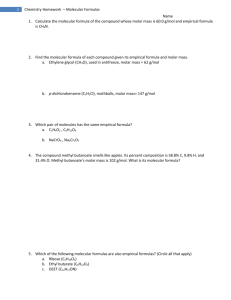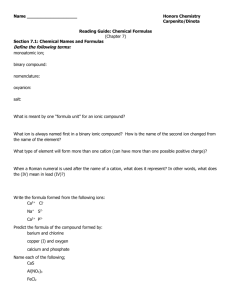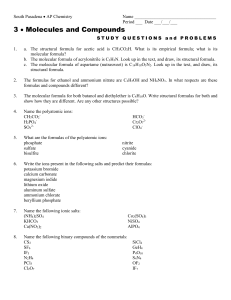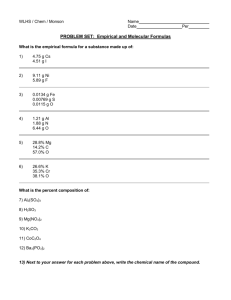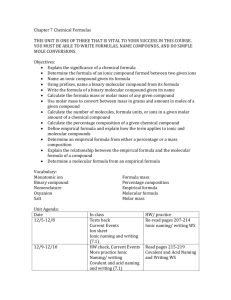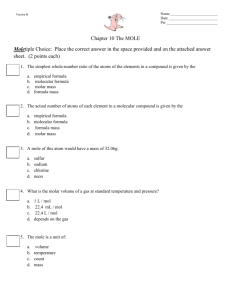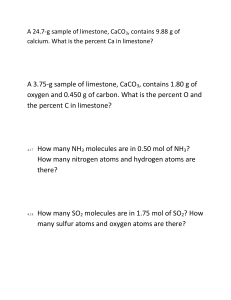Example - Cloudfront.net
advertisement
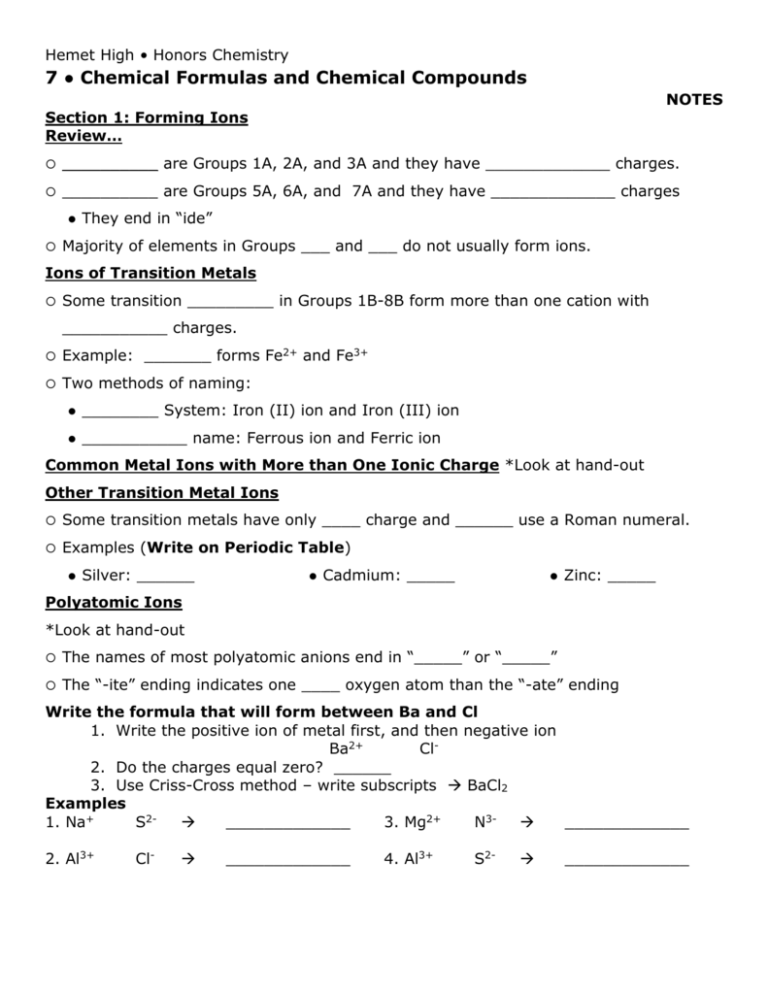
Hemet High • Honors Chemistry 7 ● Chemical Formulas and Chemical Compounds NOTES Section 1: Forming Ions Review… __________ are Groups 1A, 2A, and 3A and they have _____________ charges. __________ are Groups 5A, 6A, and 7A and they have _____________ charges They end in “ide” Majority of elements in Groups ___ and ___ do not usually form ions. Ions of Transition Metals Some transition _________ in Groups 1B-8B form more than one cation with ___________ charges. Example: _______ forms Fe2+ and Fe3+ Two methods of naming: ________ System: Iron (II) ion and Iron (III) ion ___________ name: Ferrous ion and Ferric ion Common Metal Ions with More than One Ionic Charge *Look at hand-out Other Transition Metal Ions Some transition metals have only ____ charge and ______ use a Roman numeral. Examples (Write on Periodic Table) Silver: ______ Cadmium: _____ Zinc: _____ Polyatomic Ions *Look at hand-out The names of most polyatomic anions end in “_____” or “_____” The “-ite” ending indicates one ____ oxygen atom than the “-ate” ending Write the formula that will form between Ba and Cl 1. Write the positive ion of metal first, and then negative ion Ba2+ Cl2. Do the charges equal zero? ______ 3. Use Criss-Cross method – write subscripts BaCl2 Examples 1. Na+ S2 _____________ 3. Mg2+ N3 _____________ 2. Al3+ Cl- _____________ 4. Al3+ S2- _____________ Use the Criss-Cross Method to Write Formulas using the following: Cl- N3- OH- CO32- PO43- Na+ Ca2+ Al3+ NH4+ _________________:are composed of 2 elements & can be either ionic or molecular. Naming Binary Ionic Compounds To name a binary ionic compound, place the _______ name first, followed by the ________ name. Remember the anion ends in “-_____” Examples: Cs2O _______________ NaBr _______________ CuO _______________ Naming Compounds with Polyatomic Ions State the _______ first and then the _______ just as you did in naming binary ionic compounds. KNO3 ________________ Mg(ClO2)2 ________________ Naming Binary Molecular Compounds Binary molecular compound: must be composed of two _____________ Use _________ to indicate the number and kind of atom in the compound Use the following general format: 1st name: prefix + element name 2nd name: prefix + element name + “ide” If there is only one of the 1st element, no prefix. Examples: Name the following: CO ________________ N2 O ________________ CO2 ________________ Cl2O8 ________________ Writing Formulas for Binary Molecular Compounds Use the __________ in the name to tell you the ______________ of each element in the formula. Then write the correct ______________ for the two elements with the appropriate _______________. The least electronegative element is written first. Dinitrogen Tetroxide - ____________ Examples Write formulas for the following: Nitrogen Monoxide ________________ Carbon Tetrachloride ________________ Diphosphorous Pentoxide ________________ Naming Acids An acid is a compound that contains _____ or more ___________ atoms and produces hydrogen ions (H+) when dissolved in water. All acids begin with _______________ General Format: HnX “X” represents a monatomic or polyatomic anion. “n” represents the number of hydrogen ions 3 Rules for Naming Common Acids If the name of “X” ends in -ate: ____________-ic acid If the name of “X” ends in -ite: ____________-ous acid If the name of “X” ends in -ide: hydro-__________-ic acid Name these acids H2SO4 ________________ HCl ________________ H2S ________________ HNO3 ________________ HClO2 ________________ Writing Formulas for Acids If the acid ends in -ic, then “X” ends in -ate. If the acid ends in -ous, then “X” ends in -ite. If the acid has hydro-________-ic, then “X” ends in -ide. The subscript on hydrogen is equal to the charge of “X”. Write the Formula for the Following Acids Hydrobromic Acid ________________ Carbonic Acid ________________ Phosphoric Acid ________________ Sulfurous Acid ________________ Homework: 7.1 page 251 #14, 15(a-d), 41 Section 3: Using Chemical Formulas The Mass of a Mole of an Element • Molar Mass: is the atomic mass of an element expressed in grams/mole (g/mol). • Carbon = _________ g/mol • When dealing with molar mass, round off to ____ decimals. • 12.011g/mol 12.01g/mol • Hydrogen = __________ g/mol The Mass of a Mole of a Compound • You calculate the mass of a molecule by ___________ the molar masses of the atoms making up the molecules. • Example: H2O • Molar Mass of H2O = • This applies to both ____________ and ________________ compounds • Find the molar mass of PCl3 • What is the molar mass of Sodium Hydrogen Carbonate (NaHCO3)? Converting Moles to Mass • You can use the ______________ of an element or compound to convert between the mass of a substance and the moles of a substance. • # of moles mass( g ) Mass (g) = 1 1 mole Example 1: If molar mass of NaCl is 58.44 g/mol, what is the mass of 3.00mol NaCl? Example 2: What is the mass of 9.45 mol of Aluminum Oxide (Al2O3)? Converting Mass to Moles • You can invert the conversion factor to find ______ when given the mass. mass( g ) 1 mole Moles = 1 mass( g ) Example 1: If molar mass of Na2SO4 142.05 g/mol, how many moles is 10.0 g of Na2SO4? Example 2: How many moles are in 75.0 g of Dinitrogen Trioxide? Percent Composition • Percent Composition: the relative amount of the elements in a compound. • Also known as the percent by _________ • It can be calculated in ____ ways: – Using Mass Data – Using the Chemical Formula % Composition from Mass Data % mass of element= mass of element x 100% mass of compound • Example: Percent Composition of K2CrO4 • K = 40.3%, Cr = 26.8%, and O = 32.9% • The percents must total 100% or really close to it. • Key Fact: percent composition of a compound is always the same regardless of the amount of compound present. Example • When a 13.60 g sample of a compound containing Mg and O is decomposed, 5.40 g O is obtained. What is the % composition of this compound? Mass of compound: Mass of oxygen: Mass of magnesium: % Mg = %O= Find the percent composition of Cu2S. • Find mass of Cu and S – Cu2 = –S= • Find mass of Cu2S = % Composition % Cu = %S= Find the percentage by mass of water in the hydrate Na2CO3•10H2O Homework: 7.3 page 253 #30-33 Section 4: Determining Chemical Formulas Empirical Formulas • Empirical Formula: shows the _____________ whole-number ratio of the atoms of the elements in a compound. • Example: – The EF for Hydrogen Peroxide (H2O2) is HO with a _____ ratio. – The EF for Carbon Dioxide (CO2) is CO2 with a ______ ratio. Determining the Empirical Formula of a Compound • A compound is found to contain 25.9% Nitrogen and 74.1% Oxygen. What is the Empirical Formula of the compound? Molecular Formulas • Molecular Formula: tells the _________ number of each kind of atom present in a molecule of a compound • Example: – The Molecular Formula for Hydrogen Peroxide is H2O2. – The Molecular Formula for Carbon Dioxide is CO2 • It is possible to find the ____________ Formula using the __________ Formula if you know the molar mass of the compound. Finding the Molecular Formula • Calculate the molecular formula of a compound whose molar mass is 60.0 g/mol and empirical formula is CH4N • Step 1: Find the empirical formula molar mass • Step 2: Divide molar mass by EF molar mass and round to whole #. • Step 3: Multiply empirical formula by the answer from Step 2. Homework: 7.4 page 253 #36-38
